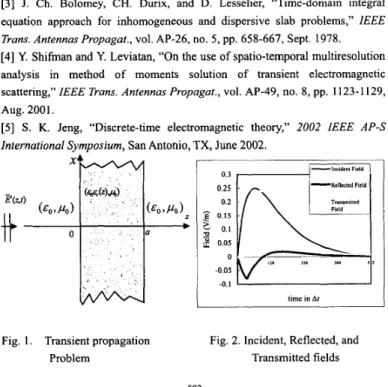A Staircase-Approximation Time-Domain Matrix Integral Equation Approach to the Computation of One-Dimensional Transient Propagation
through an Inhomogeneous Slab*
Shyh-Kang Jeng
Department of Electrical Engineering and Graduate Institute of Communication Engineering,
National Taiwan University Taipei, Taiwan email 4ieng(cicw ee ntii cdu tw Abstract
A novel method based on the staircase-approximation time-domain matrix integral equation (SATDMIE) is proposed to solve one-dimensional transient propagation through an inhomogeneous slab. A numerical scheme is developed to compute the transient response iteratively. This scheme only needs to factorize a K by K matrix once, and requiresO(NK’)storage and matrix element computations. Here Nand K are the number of time steps and spatial divisions, respectively. The whole theory framework is quite general. It can be extended to solve 3D problems like the transient radiation and scattering of wire antennas.
Introduction
The staircase-approximation time-domain (SATD) method [ 1][2] has been successfully applied to transmission line transient problems. In order to extend it to general electromagnetic problems, the author tries the one-dimensional transient propagation through an inhomogeneous slab as the first step. Although this problem has been solved by time-domain integral equation [3][4], and could also be computed via taking the inverse Fourier transfonn of the frequency domain solution, the proposed new approach is efficient and easier to formulate as well as generalize,
*Supported by contract NSC91-22 13-E-002-075, National Science Council, Taiwan.
Problem
Consider a plane wave i E i ( z , t ) = i j ( t
-4)
incident upon a dielectric slab with dielectric constant E , ( z ) in free space as shown in Fig. 1. The transient behaviors of the reflected field at z = 0 and the transmitted field atz = a are to be computed.
C
2 [ D m . l = ,
Matrix Integral Equation
electromagnetic theory [ 5 ] , to expand the total field
Apply the SATD approach [1][2], as a special case of discrete-time
N-l E ( z , t ) =
c
E" (z)h, ( 1 ) = [E. (Z)T [h,011
( 1 ) "4 1 0 0 0...
- 2 1 0 0 " ' 2 - 2 1 0...
- 2 2 - 2 1...
. .. . .
..
.
.
.
.
.
.
.
.
(3)A matrix Green's function corresponding to (2) satisfying
(4)
d 2 1
4
~ [ C - . C Z > z71= -[Dm.P [G,,(z,
.*)I-
6(z - Z')[%"l-'[D,]z-t
is solved as [G,,(z,z')]=~e
'"
[ D m n r ' . With this Green's function and (2), the scattered field can be written as2
(5)
Numerical Solution Scheme
K-l
To solve the matrix integral equation ( 6 ) , we expand E n ( z ) = ~ E ~ ) , k ' b , ( z ) ,
k=O
1, kAz < z I ( k +l)Az
, with b = a / K . 0, otherwise
where the spatial basis functionb, ( z ) =
Substituting this expansion into (6) and matching the equation at
z , = (1
+
1 / 2)Az , I = 0, I, 2,. . ., K - 1 , we achieve the following recurrence formula[E!:)]= (16(l.k)]+ [p~l,k)D-'{[,si)
J - ~ [ P , , ~ ~ ) I E ~ ~ ) ~ ,
m = 0,1,'2, ..., N - I(7)
*=O
where [6","'] is an identity matrix of order K , 5';) = E:(z,) , and
c:8!'f)
= [(zr(zt) - l b m - n ( l z , - z'l)b, ( z ' ) d z ' , Through this recurrence equationwe solve [E!:'] iteratively in time. Note that in (7) the matrix inversion needs only be factorized once by LU decomposition. This is in contrast to the frequency domain approach, where N matrix inversions must be done. On the
other hand, computing the matrix elements in the frequency domain approach requires O ( N K ' ) computation and O ( K 2 ) storage. For the SATDMIE approach, we have to save [Pi::)] , whose computational and storage
complexities are both O ( N K ' ) . Note also that [g,_n(lzp
-='/)I
can be calculated efficiently using the fast algorithm in [2]Verification
The above scheme has been implemented as a C++ program. Figure 2 is
the computed transient behaviors for a homogeneous slab with E , = 5
,
a = 8c,At , Az = coAt , f( t ) = - e-‘lsoA’)U(t) and U ( t ) the unit stepfunction. The three 512-point curves agree with those obtained by taking the inverse FFT of the analytic frequency-domain solution. They were computed through a notebook PC with a Pentium 111 1.13 GHz CPU and a 256 M memory in 49 seconds.
References
[ l ] I. T. Chiang and S . K. Jeng, “Staircase approximation for transients of multisection dispersive transmission lines with nonlinear loads.” 2001 IEEE
AP-S International Symposium, Boston, MA, July 2001.
[2] I. T. Chiang, Matrix Approaches for Transient Analysis of Complex Transmission Line Circuits Using HWSD and SATD, Ph.D. Thesis, National
Taiwan University, Taipei, Taiwan, 2002.
[3] J. Ch. Bolomey, CH. Durix, and D. Lesselier, “Time-domain integral equation approach for inhomogeneous and dispersive slab problems,” lEEE
Trans. Antennas Propagat., vol. AP-26, no. 5, pp. 658-667, Sept. 1978. [4] Y. Shifman and
Y.
Leviatan, “On the use of spatio-temporal multiresolution analysis in method of moments solution of transient electromagnetic scattering,” IEEE Trans. Antennas Propaguf., vol. AP-49, no. 8, pp. 1123-1 129, Aug. 200 1.[5] S . K. Jeng, “Discrete-time electromagnetic theory,” 2002 IEEE AP-S International Symposium, San Antonio,
Fig. 1 Transient propagation Problem X, June 2002. ____ 0.3 0.25 0.2 E 0.15
4
-
0.12
0.05 0 -0.05 -0. I timc in A1Fig. 2. Incident, Reflected, and Transmitted fields
